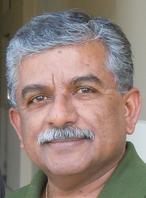Seminars in Hearing Research (04/04/24) - Ananthanarayan Krishnan
Seminars in Hearing Research (04/04/24) - Ananthanarayan Krishnan
| Author: | M. Heinz |
|---|---|
| Event Date: | April 4, 2024 |
| Hosted By: | Maureen Shader |
| Time: | 12:00 - 1:00 pm |
| Location: | NLSN 1215 |
| Contact Name: | Shader, Maureen J |
| Contact Email: | mshader@purdue.edu |
| Open To: | All |
| Priority: | No |
| School or Program: | Non-Engineering |
| College Calendar: | Show |
Seminars in Hearing Research at Purdue (SHRP)
Date: Thursday, April 4, 2024
Time: 12pm - 1:00pm
Location: NLSN 1215
Title: The spatiotemporal organization of the pitch processing network is shaped by tonal language experience.
Speaker: Ananthanarayan Krishnan PhD, Professor, SLHS.
Abstract: There is compelling evidence that tonal language experience shapes neural representations of pitch in the auditory brainstem and cortex. However, crucial questions remain about the spatiotemporal organization of this distributed pitch network. (1) How does language experience change the spatiotemporal dynamics and coordination of pitch processing at different stages/time windows (when) along the processing hierarchy? (2) Does language experience selectively reconfigure the brain regions, their connectivity strengths, and hemispheric preference at the different stages (where) based on functional demands? (3) Does language experience preferentially drive temporal and/or spectral cue-based mechanisms of pitch encoding (how)? Our long-term objective is to advance knowledge of how language experience shapes the spatiotemporal (when, where, and how) reorganization of the brain and its underlying pitch circuitry. Using a cross-linguistic (Mandarin vs. English) design, we propose a novel multimodal neuroimaging approach that integrates EEG-derived pitch-specific responses with fMRI and functional connectivity measures to assess the brain processes subserving language-dependent tuning of pitch representations at different spatial scales and temporal windows of processing. The long-term goal is to advance our understanding of how language experiences reconfigure the distributed processing network to optimally represent behaviorally relevant acoustic, and linguistic features of dynamic pitch. Our central hypothesis is that tonal language experience reconfigures the spatiotemporal dynamics of the brain’s pitch networks according to functional language demands, which in turn, enables optimal neural encoding of linguistically relevant features of the acoustic signal. To this end, we utilize a functionally motivated theoretical framework that views pitch processing as a distributed hierarchical process that involves coordination between multiple stages/time windows of processing in cortical and subcortical regions utilizing local, bottom-up, and top-down processes to address these questions. This presentation will present preliminary evidence addressing Aim 1 which will characterize brainstem and cortical EEG derived pitch specific measures, fMRI activation patterns, and EEG derived functional connectivity measures reflecting early sensory level pitch processing in response to speech and non-speech sounds with native and non-native pitch contours. We aim to show that experience-dependent effects: (i) at the early sensory level processing in the brainstem and auditory cortex, target neural encoding of only the linguistically relevant dynamic temporal attributes of native pitch contours with a left ear advantage (brainstem) and a right hemispheric (RH) preference (auditory cortex irrespective of domain; (ii) will selectively recruit the language network bilaterally (including the pSTG-aSTG axis, temporal pole and IFG) for native pitch contours irrespective of domain but in Mandarin speakers only. Also, EEG derived functional connectivity measures will show a more organized connectivity between early sensory and downstream language related components only in the Mandarin group. These early results are promising and suggests that the spatiotemporal dynamics in the pitch processing is selectively influenced to enhance neural representations of pitch subserving both auditory and linguistic function.
The working schedule is available here.
Titles and Abstracts are added here.

